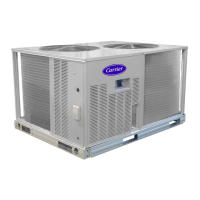17
To correct phase order:
1. Turn off power to the unit , tag disconnect.
2. Reverse any two of the unit power leads.
3. Reapply power to the compressor, verify correct
pressures.
To verify the compressor is rotating in the prop er
direction:
1. Connect service gages to the suction and liquid pres-
sure fittings.
2. Energize the compressor.
3. The suction pressure should drop and the liquid
pressure should rise, as is norm al on any start--up.
Compressor Overload —
This overload interrupts power to the compressor when
either the current or internal motor winding temperature
becomes excessive, and automatically resets when the
internal temperature drops to a safe level. This overload
may require up to 60 minutes (or longer) to re set. If the
internal overload is suspected of bei ng open, disconnect
the electrical power to the unit and check the circuit
through the overload with an ohmmeter or continuity
tester.
Advanced Scroll Temperature Protection (ASTP) —
A label located above the terminal box identifies Copeland
Scroll compress or models that contain this technology. See
Fig. 17. Advanced Scroll Temperature Protection (ASTP) is
a f or m of internal dis charge temper atur e pr otectio n, that
unloads the scroll compressor when the internal temperature
reaches approx imately 149_C (300_F ). At this temperature,
an inter nal bi--metal disk valve open s and caus es the scroll
elements to separate, which stops compression. Suction and
discharge pressures balance while the motor continues to
run. The longer the compressor runs unloaded, the longer it
must cool before the bi--metal disk resets. See Fig. 18.
To manually reset ASTP, the compressor should be
stopped and allowed to cool. If the compressor is not
stopped, the motor will run until the motor protector tri ps,
which occurs up to 90 minutes later. Advanced Scroll
Temperature Protection will reset automatically before the
motor protector resets, which may take up to 2 hours.
C10080
Fig. 17 -- Advanced Scroll Temperatur e Protection Label
0
10
20
30
40
50
60
70
80
90
100
110
120
0 10203040 607080 9050
Compressor Unloaded Run Time (Minutes)*
*Times are approximate.
NOTE: Various factors, including high humidity, high ambient
temperature, and the presence of a sound blanket will
increase cool-down times.
Recommended Cooling Time*
(Minutes)
C10081
Fig. 18 -- Recommended Minimum Cool-Down Time
After Compressor is Stopped
Start Unit
Set the space thermostat to a set point above space
temperature so that there is no demand for cooling. Close
the 38AU disconnect switch. Only the crankcase heater
will be energized.
Reset the space thermostat below ambient so that a call
for cooling is ensured.
UNIT DAMAGE HAZARD
Failure to follow this caution may result in equipment
dama ge.
Never charge liquid into the low-pressure side of
system. Do not overcharge. During charging or
removal of refrigerant, be sure indoor-fan system is
operating. Ensure both outdoor fan motors are
running; bypass any Motormaster function.
CAUTION
!
Adjust Refrigerant Charge —
Refer to Coolin g Charging Chart, Fig. 19. Fo r applications
with line lengths greater than 125 ft (38 m), contact Carr ier
representative. Vary refrigerant until the conditions of the
chart are met. Note that the char g ing charts are different
from the type normally used. The charts are based on
charging the units to the correct subcooling for the various
operating conditions. Accurate pressure gage and
temperature sensing device are required. Connect the
pressure gage to the service port on the liquid line service
valve. Mount the temperature sensing device on the liquid
line close to the liqu id line service valve, and insulate it so
that outdoor ambient temperature does not af fect the reading.
Indoor airflow must be within the unit’s normal operating
range. Operate the unit for a minimum of 15 minutes.
Ensure that pressure and temperature readings have
stab ilized. Plo t the liquid press u re and temperature on chart
and add or reduce the charge to meet the curve. Adjust the
charge to conform with the char ging chart, using the liquid
pressure and temperature to read the chart.
38AU

